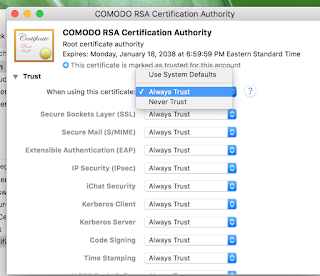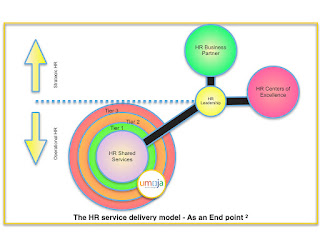Executive overview of Operating Model in HR- A Perspective
By Siva Kumar
Prelude
Every project which is transformational, needs a perspective to appreciate the complexities at the same time provide the decision makers to understand the overall picture, identify potential risks and benefits and be able to make choices based on rational and practical point of view.
Umoja is a transformational project and has lot of moving parts and it needs to be understood from the architectural perspective to better appreciate tall the features as well as the limitations. On a whole, the core objective of any global ERP implementation is to implement a consistent and state of the art transactional and reporting system supported by a performance management system. The success of such projects heavily depends on the way in which the services are delivered across the globe. This feature is often referred in the business world as a global delivery model or Global service delivery model. Umoja is such project and the objective of this document is to establish the options for the operating model for HR based the global delivery objectives. I also wish to shed a light on the overall approach I had with the OHRM leadership in building the architectural components and the journey for the past 3 years in realizing the strategic outlook established in the first place.
Global Delivery Model
Global Delivery model is defined, “The optimum combination of processes, end-to-end methodologies and quality procedures, with high-quality skills and resources available internally or externally, in requisite quantities, on a global basis, that enables organizations to maximize the quality of their solutions while minimizing the overall cost and delivery time of their IT services.” 1
Since Umoja is going to be a global system, the model definition suits perfect, but we now focus on the main focus areas that will allow us to achieve the objective as explained above. There are four main focus areas that drive the enablement of the GSD model. They are
Governance: Which establishes executive oversight and Organizational Policies
Organizational Structure: Dictates and defines the organizational Design, Roles and Responsibilities and tagging of centralized and decentralized activities.
Operational Procedures: Implemented through Enterprise Architecture, Developing and deploying consistent transactional services across the eco-system and emphasis on geographic focus.
Performance Management: establishing a Performance management framework to clearly track and establish cost and performance transparency and a feedback loop to the other pillars for necessary corrective actions.
The beginning
Around the world, over the past two decades the HR function has undergone a process of transformation – with varying levels of success. Recognizing the critical linkage between talent management and business success, OHRM leadership were looking that their HR functions to play an increasingly strategic role in achieving business objectives. At the same time, they are looking to wring costs from HR service delivery, as well as manage program spend, in order to redirect funds to other business imperatives.
As a starting point, OHRM leadership had already working forward with a service delivery model in which transactional services, program design, and strategic business support are carried out by three groups within the HR function:
▪ HR Business Partners consult with business leaders on people issues
▪ Centers of Expertise (COEs) focus on the design of HR programs and policies
▪ Shared Services Centers deal with day-to-day HR service delivery
While this model has improved HR performance, exceeding the capabilities of a model in which HR services are aligned purely functionally, the leadership felt has not enabled HR to meet the ever-increasing expectations of business leaders or fully support business needs. When we sat down and started asking them, what exactly were their pain points, they started deliberating and came up with a list of twelve main concerns, either directly or indirectly about the model that were implementing and/or planning to do with the legacy systems. They are:
- Not Strategically Driven
- HR capability - Less staff ownership
- Limitation to provide top-notch transactional Services
- Limited satisfaction in self-service technology by employees and managers
- Lack of support for line managers
- Ineffective geographic focus
I started working out the model, with the Umoja transactional services and the support structure that were evolving with a competing model for the next generation HR service delivery model with a non-destructive reconstruction.
Then we started to work on a seven-step roadmap to realize the transformation framework to achieve the requires functionality. Based on my experience and the organizational maturity with respect to the new system, we had devised four major milestones in achieving the endpoint and to be ready for the deployment when it comes to HQ and cluster 4. The transformation framework was consulted with the OHRM leadership and they took care of the management task of preparing the organization to change. The transformation framework is an industry standard practice for an enterprise architect, where the goal is to identify the start and end state and clearly draws the blueprint to achieve the same.
Realization
Once the Framework is established, the road map was drawn to facilitate the first milestone. Every part of the roadmap was discussed and got the sign off from the process owners so that the clarity on the direction and ever changing business needs were also clearly addressed. the road maps and the main execution containers are:
1. Foundation: The OHRM leadership were told of the nature of the ERP project and the necessity of their commitment and conviction on this journey. The fowling are the key elements that were discussed and agreed upon with the leadership.
- Top-Down: Requires Management Directive/Decisions
- Governance: Must be clearly and explicitly defined
- Reliance: on fact-based decisions
- Shift: Some locations must shed transactional services to drive & implement new approach
2. Drawing Board: SAP as a software provides two clear hierarchical structures to enable and establish service delivery model. They are Enterprise Structure that drives the financial part of the business and the HR organizational structure that drives the Human resource part of the business. In many, if not all private sector organizations, the two will be more or less same. However in UN, there were a vast difference, and it was indicated that the HR organization structure will be used in principle, however there might be a need for a transient operative structure to manage the exceptions and outliers. It was agreed that we will provision a design plug in order to establish an operative structure in the middle, based on the HR organizational structure.
3. Architecture: The enterprise roles were built as a job function and elaborate discussions were made with the process owners and various stakeholders to establish the enterprise role catalog and were all duly signed off.
4. Build: During this process, the processes that were handled by different job functions were consolidated. One of the main consolidated constructs was the HR Partner that encompassed both PA&Contract part and Entitlement part. There was a provision established for an HR Administrator, who can act on behalf of the staff member if needed.
5. Extend: As the roles were build, We made a clear tagging to these roles as various control point levels. The roles were categorized as ESS roles, Global Roles, Central Roles, Entity roles and within Entity roles. Since we have the control points separated from the roles, we were able to bring the operation center role fairly simply as a natural and organic extension process.
6. Provision: The Enterprise role which dictates what you can do and the control points dictating where you can do, we were able to achieve an absolute automation of role provisioning and workflow management.
7. Deployment: Once the model is built and ready, we deployed in three major roll outs and we were able to realize the flexible and scalable nature by deploying various features as below:
Stand Alone: MINUSTAH, ESCAP
Operation Center: Nairobi Operation center including UNON, UN-HABITAT and UNEP
Hybrid: UNAKRT managed by New York & Payroll by ESCAP
Exception: Once in Umoja (transitional)
Standard and typical models under the service delivery will have only one construct, which is the composition of more than one entity under an operating center model. This is a very clean approach and is very stable, scalable and agile model - with respect to the changes in the service delivery location, changes in the business process decision, etc. However, based on the existing working agreements and the functionalities around and supporting the HR services can not be in a position to operate in the same model simultaneously (such as procurement, travel etc).
To satisfy that requirement, we have established a operative model, that will be established in the design time as and when an operation center is established. The following architecture explains the nature of the HR operations only and will give an indication that the same model can be brought in to other structures, if needed in a later time.
SAP and Umoja as a solution can provide two options that are technically viable and will provide the necessary functionality. However, we leave it to the process owners to decide a model that will suite them as a sustainable and scalable solution.
The models are:
Enhanced service delivery model
In this model, the budgetary structure is kept as the same for operative structure. Any components or part of components that need to be managed in part by another entity needs to me moved under the managed entity. Technically this solution is very easy, as there is no change to the composition of the entity model. Since the structure used is one and unique, the access component and the workflow component are one and the same.
This model brings in a lot of value, however may change the underlying budgetary structure, that may not be encouraged by organizations that want to keep the budgetary structure always in line with the actual budget allocation and consumption.
2. Managed service delivery model:
In the managed service delivery model, the Budget structure is delinked from the operational structure, however will model on that. This way the managing entity can encompass a part of another organizational unit under its operations. Since there are two distinct structures, the access and workflow will also change.
With the example below, the three part organizations will be managed both by their parent entity and the operational entity, however, when a staff member under this unit creates a request, it will only be routed to the operational structure head and will ignore the budget structure. This way the geographic focus can be achieved to a greater degree. This model will suit all the organizations, that have wide spread geographic presence - can be better managed by the nearby operation centers.
Conclusion
Umoja project have three distinct models that can be used to leverage the service delivery within HR and travel modules. As explained, the same functionality can be spread to other processes at the alter stage, based on the requirements.
References:
HR service Delivery Model - Bersin & Associates’ 2013 High-Impact HR Organization®
The HR Transformational Framework - Mercer Signature Events
SAP Developer network - HR service Delivery & Outlook, March 2012 Budapest
















